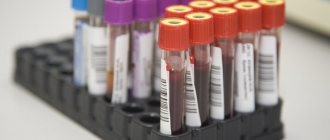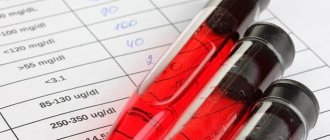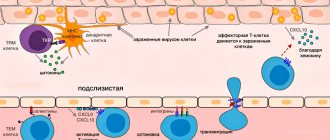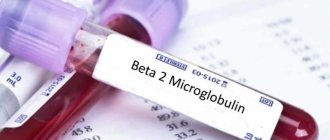Detailed description of the study
ESR, or erythrocyte sedimentation rate, is an indicator that is determined during a general clinical blood test. In an earlier interpretation, the study is called ESR (erythrocyte sedimentation reaction). The essence of the study is to measure the speed at which red blood cells (erythrocytes), after special treatment, settle in a vessel under the influence of gravity. To do this, a substance that prevents clotting (anticoagulant) is added to whole blood after collection. Then it is placed in a thin measuring vessel - a capillary. Red blood cells have a higher specific gravity compared to blood plasma, which serves as the basis for the sedimentation process, that is, the settling of these cells. As a result, the liquid in the capillary is divided into two layers: plasma is in the upper part, red blood cells are in the lower part. The height in millimeters of the top layer formed in the capillary within an hour is an indicator of ESR. The surfaces of red blood cells have the same electrical charge, due to which they do not aggregate in the bloodstream, that is, they do not stick together, but repel each other. If the amount of charge on the membranes decreases, red blood cells are able to connect, like “coin columns”. In this form, the settling process occurs at a faster rate. The strength of the charge on the surface of red blood cells, and therefore the ESR, directly depends on the composition of the blood plasma. Inflammation of any nature leads to an increase in the concentration of the so-called acute phase proteins of inflammation, or acute phase markers (C-reactive protein, haptoglobin and others). These proteins are adsorbed on the surface of red blood cells, reduce the charge of their membranes and thereby lead to the formation of “coin columns”. ESR is often determined in conjunction with a general blood test and leukocyte count during a preventive examination, monitoring the course of inflammatory and infectious diseases, and assessing the effectiveness of treatment. However, the ESR level is a nonspecific indicator that can change not only due to pathological processes in the body, but also depending on certain physiological characteristics. Thus, an increase in ESR is observed during pregnancy and menstruation. In women, the value of this indicator is, on average, higher than in men.
University
→ Home → University → University in the media → Disease or normal? What will the ESR tell you?
A clinical blood test ranks first in the list of mandatory methods for assessing our health and is important for identifying a number of diseases. Despite the fact that the blood of a healthy person strives for constancy in its quantitative and qualitative composition, in everyday practice doctors note certain fluctuations. This also applies to the erythrocyte sedimentation rate (ESR). And although a competent interpretation of a general blood test is within the competence of a doctor, some general understanding of hematological parameters will help, if something happens, to contact a specialist in a timely manner. What is hidden behind the abbreviation “ESR” and should you worry if the result does not coincide with the norm?
The erythrocyte sedimentation rate measures how quickly the blood separates into plasma (the liquid part) and formed elements. If you add an anticoagulant (a substance that prevents clotting) to a vertically mounted test tube, the blood will gradually separate into two layers under the influence of gravity: translucent plasma will be on top, and settled red blood cells will be at the bottom. Thus, ESR is estimated by the height (in millimeters) of the top layer formed within one hour. The normal value of this indicator depends on age, gender and certain physiological conditions of the body (for example, pregnancy, menstruation). In an adult, ESR can fluctuate within a fairly wide range: 0 - 15 mm/h in men and 0 - 20 mm/h in women, which is associated with gender and other differences in the chemical composition of the blood and its level of viscosity. During pregnancy (starting from the 5th week) and in the postpartum period, ESR values increase to 20 - 25 mm/h, and in older people they can reach 30 mm/h and higher. In some cases, an increase in ESR above normal is associated with the presence of bad habits (smoking, addiction to alcohol), the nature of the diet (low-calorie
diet or, conversely, overeating), individual characteristics of the body. Let's say, according to some data, almost 5% of the planet's population has an accelerated erythrocyte sedimentation reaction from birth, but there are no obvious pathological reasons for this. Therefore, if you receive an analysis result with an elevated ESR level, you should first exclude the influence of the factors listed above. Otherwise, too rapid precipitation of red blood cells is a sign of the development of one or even several inflammatory (including infectious) diseases: viral hepatitis, influenza, pneumonia, pyelonephritis, rheumatism, arthritis, etc. After all, inflammatory processes in the human body lead to the accumulation of special protein molecules in the blood that accelerate the reaction of red blood cell adhesion. Other causes of high ESR may include previous trauma or surgery, anemia, pathology of the kidneys or thyroid gland, malignant tumors, or taking certain medications (estrogens, oral contraceptives). A reduced (close to zero) level of ESR is relatively rare and is caused primarily by chronic heart and liver diseases, excess production of red blood cells, treatment with aspirin, prednisolone, etc. In order for the results of the analysis (especially the detailed one) to be reliable, it is advisable to donate blood for research on an empty stomach or at least no earlier than 4 hours after a meal, excluding increased physical activity the day before, stress and anxiety, as well as alcohol consumption. And remember: it is impossible to make a correct diagnosis based only on the ESR indicator - this requires the participation of a specialist doctor and, as a rule, a more in-depth examination. Vladimir KHRYSCHANOVYCH , Doctor of Medical Sciences
Soviet Belarus , November 22, 2018
Share
Erythrocyte sedimentation rate (ESR)
A test that evaluates the rate of separation of blood into plasma and red blood cells. The rate of separation is mainly determined by the degree of their aggregation, i.e., the ability to stick together.
Synonyms Russian
Erythrocyte sedimentation reaction, ROE, ESR.
English synonyms
Erythrocyte sedimentation rate, Sed rate, Sedimentation rate, Westergren sedimentation rate.
Research method
Capillary photometry method.
Units
Mm/h (millimeters per hour).
What biomaterial can be used for research?
Venous, capillary blood.
How to properly prepare for research?
- Eliminate alcohol from your diet for 24 hours before the test.
- Do not eat for 2-3 hours before the test (you can drink clean still water).
- Stop taking medications 24 hours before the test (in consultation with your doctor).
- Avoid physical and emotional stress for 30 minutes before the test.
- Do not smoke for 30 minutes before donating blood.
General information about the study
Determination of erythrocyte sedimentation rate (ESR) is an indirect method for identifying inflammatory, autoimmune or oncological diseases. It is performed on a sample of venous or capillary blood, to which a substance has been added that allows it not to clot (anticoagulant). When researching using the Panchenkov method, blood is placed in a thin glass or plastic tube and monitored for an hour. At this time, erythrocytes (red blood cells), as having a large specific gravity, settle, leaving a column of transparent plasma above them. The ESR is calculated based on the distance from the upper boundary of the plasma to the red blood cells. Normally, red blood cells settle slowly, leaving very little pure plasma. For this method, a Panchenkov apparatus is used, consisting of a tripod and capillary pipettes with a 100 mm scale.
For capillary photometry (automatic analyzers ROLLER, TEST1), the kinetic “stopped jet” method is used. At the beginning of the analysis, programmed mixing of the sample occurs in order to disaggregate the red blood cells. Ineffective disaggregation or the presence of microclots can affect the final result, since the analyzer actually measures the kinetics of red blood cell aggregation. In this case, the measurement occurs in the range from 2 to 120 mm/h. The results of measuring ESR by this method have a high correlation with the Westergren method, which is the reference for determining ESR, and have identical reference values.
The results obtained using the capillary photometry method in the region of normal values coincide with the results obtained when determining ESR using the Panchenkov method. However, the capillary photometry method is more sensitive to an increase in ESR, and the results in the zone of increased values are higher than the results obtained by the Panchenkov method.
An increase in the level of pathological proteins found in the liquid part of the blood, as well as some other proteins (the so-called acute-phase proteins that appear during inflammation) contributes to the “gluing” of red blood cells. Because of this, they settle faster and the ESR increases. It turns out that any acute or chronic inflammation can lead to an increase in ESR.
The fewer red blood cells, the faster they settle, which is why women have a higher ESR than men.
What is the research used for?
- For the diagnosis of diseases associated with acute or chronic inflammation, including infections, cancer and autoimmune diseases. Determining ESR is sensitive, but one of the least specific laboratory tests, since its increase in itself does not allow determining the source of inflammation, in addition, it can occur not only due to inflammation. That is why analysis of ESR is usually used in combination with other studies.
When is the study scheduled?
- When conducting diagnostics and monitoring: inflammatory diseases,
- infectious diseases,
- oncological diseases,
- autoimmune diseases.
What do the results mean?
Reference values
| Floor | Age | Reference values |
| Male | up to 15 years | 2 - 20 mm/h |
| from 15 to 50 years | 2 – 15 mm/h | |
| over 50 years old | 2 - 20 mm/h | |
| Female | up to 50 years | 2 - 20 mm/h |
| over 50 years old | 2 – 30 mm/h |
The results of this test must be interpreted in light of clinical data, medical history, and other tests.
Reasons for increasing ESR
- Infectious diseases (usually bacterial causes). ESR can increase in both acute and chronic infectious diseases.
- Inflammatory diseases.
- Connective tissue diseases (rheumatoid arthritis, systemic lupus erythematosus, systemic scleroderma, vasculitis).
- Inflammatory bowel diseases (Crohn's disease, ulcerative colitis).
- Oncological diseases: Myeloma. As a rule, it is accompanied by a very high level of ESR, because with it pathological proteins are synthesized in large quantities, which cause the formation of erythrocyte “coin columns”.
- Hodgkin's disease is a malignant disease of the lymph nodes. The ESR indicator is usually used not to make a diagnosis, but to monitor the course and effectiveness of treatment of an already diagnosed disease.
- Cancer of various localizations, especially hemoblastosis. It is believed that an extremely high level of ESR indicates the spread of the tumor beyond the primary focus (i.e., metastases).
- Myocardial infarction. When it occurs, damage to the heart muscle occurs, which causes a systemic inflammatory response and, accordingly, an increase in ESR. After a heart attack, the ESR peaks about a week later.
- Anemia. A decrease in the number of red blood cells can lead to an increase in their sedimentation rate.
- Burns, injuries.
- Amyloidosis is a disease associated with the accumulation of pathological protein in tissues.
Reasons for decreased ESR
- Diseases accompanied by changes in the shape of red blood cells, such as sickle cell anemia or hereditary spherocytosis (they make it difficult for red blood cells to settle).
- Polycythemia (increased number of red blood cells) and conditions that lead to it, such as, for example, chronic heart failure or lung diseases.
What can influence the result?
- ESR tends to increase during pregnancy and menstruation.
- Oral contraceptives, theophylline, and vitamin A may increase ESR.
- Taking corticosteroids and administering albumin can reduce ESR.
Important Notes
- The ESR test is one of the least specific laboratory tests - an increase in ESR can be observed in many diseases, and a diagnosis cannot be made based on this indicator alone.
- Sometimes ESR can increase significantly in healthy people.
- A normal ESR does not exclude cancer or connective tissue diseases.
Also recommended
- C-reactive protein (quantitative)
- Rheumatoid factor
- Complete blood count (without leukocyte formula and ESR)
- Leukocyte formula
Who orders the study?
Therapist, oncologist, hematologist, infectious disease specialist.
Analysis transcript
All standard ESR indicators are available in a special table, where they are indicated in accordance with gender and age. In this case, only a doctor should interpret the answer received, since the result of the study can vary in any direction depending on physiological or pathological processes. To assess the situation, the specialist will take into account a whole range of related factors. At the same time, you need to know that in 5% of the world's inhabitants, the analysis shows a high ESR for no apparent reason.
| Age | Norm, mm/h |
| up to 13 years old | 4-12 mm/h |
| 13-18 years old | 3-18 mm/h |
| 18-30 years old | 2-15 mm/h |
| 30-40 years | 2-20 mm/h |
| 40-50 years | 0-26 mm/h |
| 50-60 years | 0-26 mm/h |
| after 60 years | 2-55 mm/h |
| During pregnancy | up to 45 mm/h |
ESR (venous blood)
Erythrocyte sedimentation rate (ESR) is a nonspecific indicator; is usually prescribed together with a general blood test. This test is not diagnostic of a specific disease and should not be used to screen asymptomatic patients. The erythrocyte sedimentation reaction largely depends on changes in the composition of blood proteins during physiological and pathological processes in the body.
In what cases is ESR testing usually prescribed?
Most often, erythrocyte sedimentation rate is used as a marker of the inflammatory process. In the case of acute infectious and inflammatory diseases, the ESR quickly increases (as well as another marker of inflammation - C-reactive protein); after recovery, the ESR may remain moderately elevated for some time (when the C-reactive protein has already returned to normal).
Inflammation depends on the body's immune response. The inflammatory response can be acute, occurring after injury, surgery, or infection. In other cases, inflammation can be long-term (chronic) and accompany conditions such as autoimmune diseases or cancer.
What exactly is determined during the analysis process?
If a blood sample is placed in a special narrow tube, over time you can see that the blood cells (red blood cells) settle to the bottom, and a layer of transparent plasma appears above them. This process occurs at a certain constant speed. If inflammatory response proteins, such as C-reactive protein or fibrinogen, are present in the blood, red blood cells settle faster. When determining ESR, the rate of fall (sedimentation) of red blood cells in the blood is actually measured.
What do the test results mean?
Accidental detection of an increased ESR value in a blood test in patients without complaints has no clinical significance; in this case, it is advisable to re-examine the ESR after 2-3 weeks.
A persistent significant increase in ESR, repeated in several consecutive tests, serves as a laboratory diagnostic criterion for some systemic inflammatory (rheumatic) diseases: rheumatoid arthritis, giant cell arteritis, polymyalgia rheumatica.
The international method for determining ESR according to Westergren is usually used. The upper limit of normal ESR values depends on the patient’s age and gender. The individual norm for a patient is calculated using the following formula: for women, ESR (mm/hour) = (age in years + 10)/2; in men, ESR (mm/hour) = (age in years)/2. This method for determining normal values is not used for pregnant women; ESR is usually elevated during pregnancy.
Typical test turnaround time
Usually the ESR result can be obtained within 1-2 days
Do I need special preparation for the analysis?
No special preparation required. More information about the delivery conditions can be found in the “Preparation” section.






